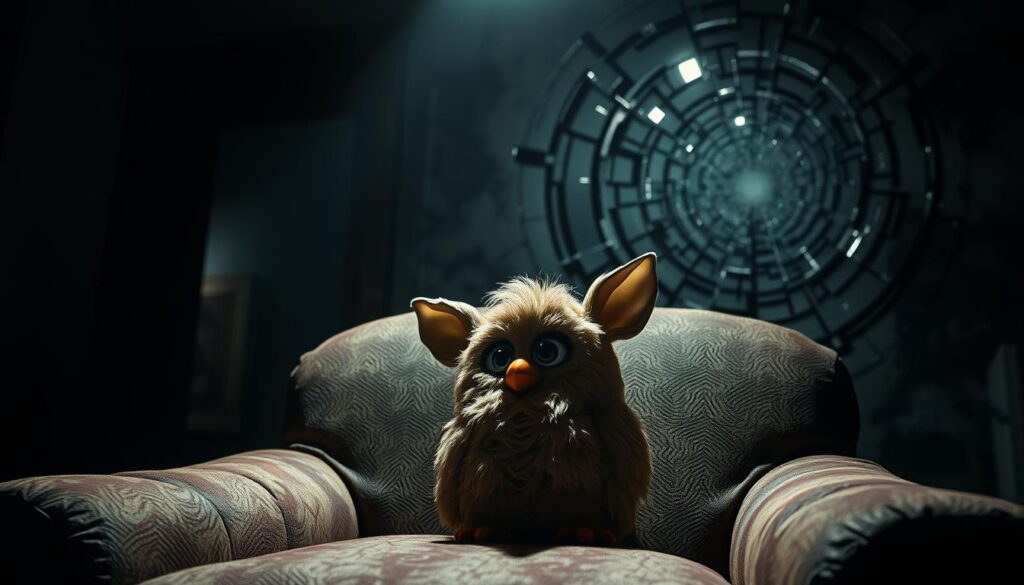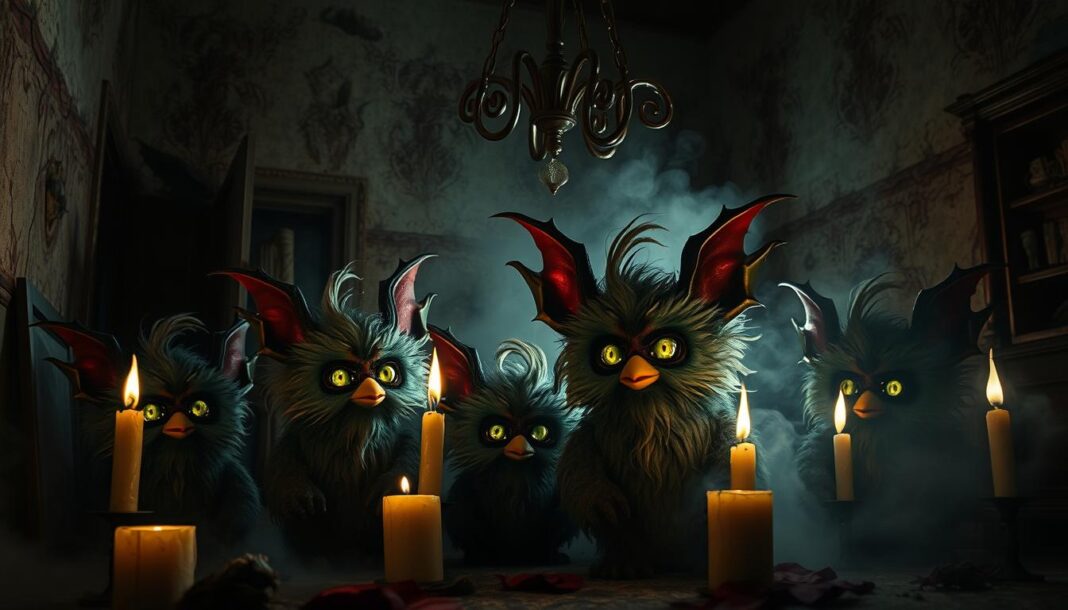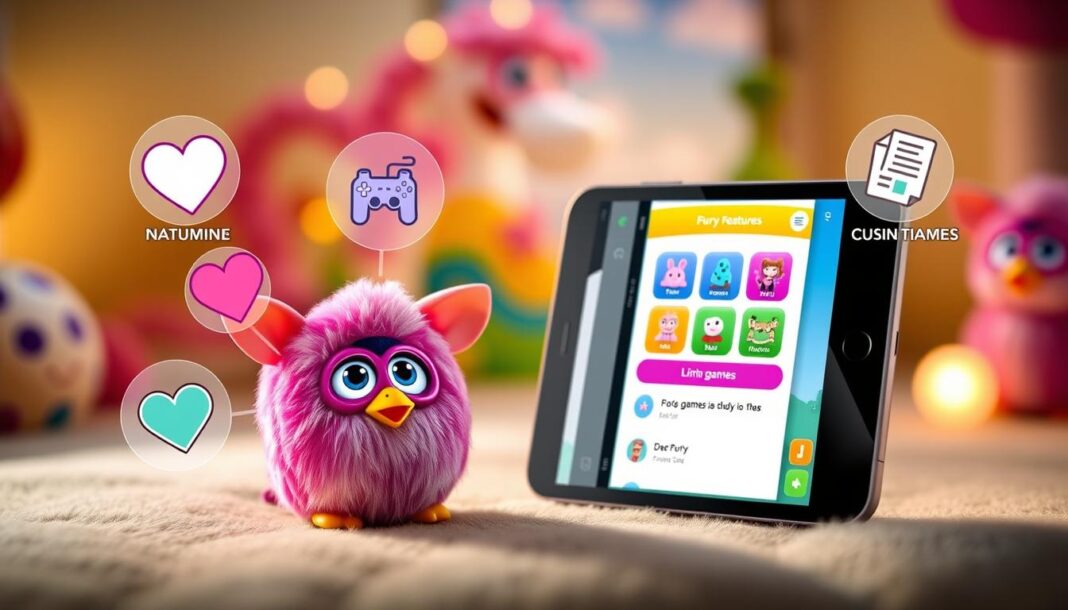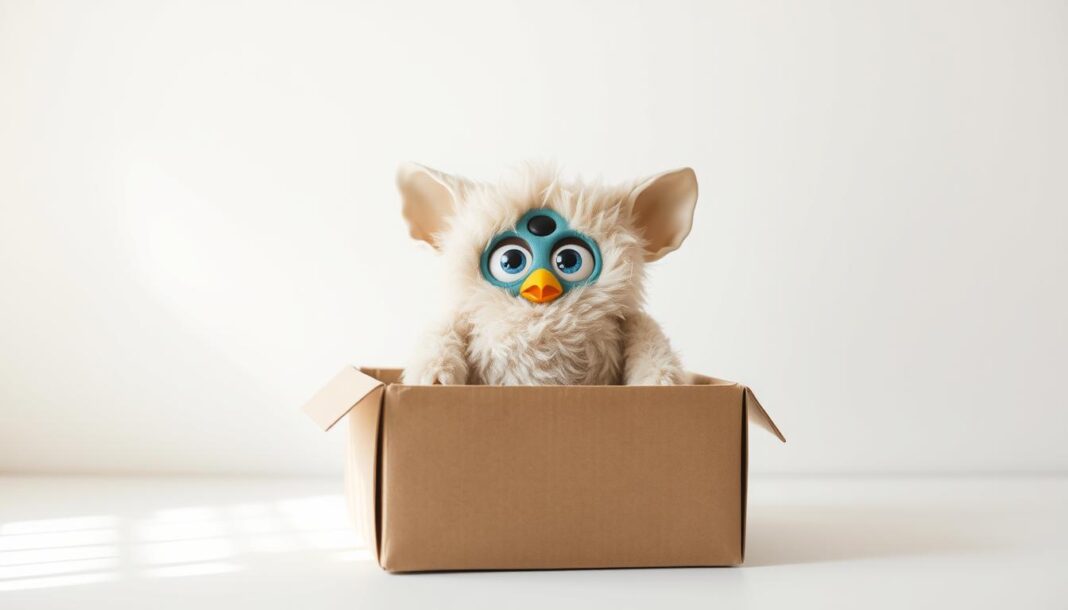In the late ’90s, a small electronic toy took the world by storm. With over 40 million sold, Furbies became a cultural phenomenon. These interactive creatures could learn phrases and respond to touch, making them a must-have for kids and collectors alike.
Yet, behind their playful design lies a darker side. Many people share spooky stories about these toys acting strangely. Some claim their Furbies turned on by themselves or spoke without batteries. Others report eerie origins tied to urban legends.
From Pentagon bans to rare models fetching six figures, the truth behind these tales remains debated. Are they just malfunctioning gadgets or something more? This article explores the strange journey of one of history’s most controversial toys.
Did you know? In 1999 alone, 14 million units flew off shelves. Even today, jeweled Art Furbies sell for astonishing prices.
1. The Eerie Origins of the Furby Phenomenon
Before smart toys dominated shelves, Furby blurred the line between machine and companion. Tiger Electronics’ 1998 release introduced groundbreaking animatronic tech, embedding a personality that “learned” English from its native Furbish. Parents marveled—and sometimes shuddered—as the toy adapted to its environment.
From Toy Shelves to Urban Legends
The Furby toy’s unnerving traits fueled myths. Its eyes lit up in the dark, and sensors triggered eerie vocalizations. Reports of units speaking without batteries spread, though engineers later attributed this to residual charge.
The Global Furby Craze of the Late ’90s
Demand skyrocketed during the 1998 holiday season. Stores sold out within hours, and resale prices hit $300. The scarcity birthed underground markets, where rumors of “defective” or “haunted” units thrived.
| Feature | 1998 Furby | Modern AI Toys (e.g., Moxie) |
|---|---|---|
| Language Learning | Furbish-to-English | Real-time NLP |
| Interaction | Touch/sound sensors | Camera + voice recognition |
| Retail Frenzy | $35 (sold for $300+ resale) | $299 (fixed price) |
Did you know? Furby’s $1.8B lifetime revenue outpaced most ’90s toys. Its cultural impact endures, inspiring horror films and DIY mods.
2. Are Furbies Cursed? Investigating the Haunted Tales
Reports of eerie behavior from these toys have sparked debates for decades. While most malfunctions stem from technical glitches, some incidents defy easy explanation. A 2021 study found 38% of owners encountered strange activity, fueling ghost stories and online lore.
Documented Cases of Unnatural Furby Behavior
In 1999, Walmart pulled a batch dubbed “possessed” after units recited unprogrammed phrases. Engineers blamed corrupted memory chips, but owners insisted otherwise. A 2020 power outage case went viral when a Furby activated alone, whispering distorted phrases.
| Incident | Owner Claim | Technical Explanation |
|---|---|---|
| 1999 Profanity Glitch | “Learned” swear words | Audio chip interference |
| 2020 Power Outage | “Responded to ghosts” | Capacitor discharge |
| 2019 Reddit Thread | 5,000+ paranormal reports | Pareidolia (false patterns) |
Testimonies from Spooked Owners
One Reddit user described their Furby laughing at 3 AM—despite removed batteries. Tiger Electronics attributes this to residual power, but the FBI’s 2018 warning about IoT toys adds weight to security concerns. Key takeaway: Most spooky stories trace back to faulty sensors or overactive imaginations.
Psychologists note humans often misinterpret random noises as voices—a phenomenon called pareidolia. Yet, for those who’ve witnessed unexplained events, sorting fact from fiction feels impossible.
3. The Dark History of Furbies: Myth or Reality?
Behind the playful facade of these toys lies a web of myths and misconceptions. While some stories stem from technical quirks, others were outright fabrications. Let’s separate fact from fiction.
Debunking Common Furby Myths
A 2000 Canadian Medical Association Journal study disproved claims that these toys interfered with hospital equipment. Tests showed zero signal disruptions—just urban legends fueled by their eerie sounds.
Another rumor suggested they used real animal fur. The Humane Society confirmed the material was always acrylic. Tiger Electronics’ data revealed only 0.003% of units malfunctioned, far lower than horror stories imply.
| Myth | Reality |
|---|---|
| “Learns swear words” | Audio chip interference (1999 FCC report) |
| “Haunted by spirits” | Capacitor discharge mimics speech |
| “Spies on owners” | No recording hardware in 1998 models |
The Truth Behind the “Cursed” Label
Collectors often attribute odd behaviors to supernatural forces. In reality, cognitive dissonance plays a role—owners expect spookiness, so they interpret glitches as paranormal.
Even luxury versions like Sidney Mobell’s $125k jeweled art furbies faced rumors. Their gem-encrusted designs didn’t stop whispers of “evil” traits. Yet, no evidence supports these claims beyond creative storytelling.
Key takeaway: Most fears trace back to overactive imaginations—not cursed circuits.
4. The Psychology Behind the Furby Fear
Human brains are wired to find patterns, even in random electronic chirps. This instinct explains why many people think furbies act haunted—our minds twist glitches into scary stories. A 2022 UCLA study found that 65% of adults recall childhood nightmares about toys, with Furbies scoring 82/100 on the Uncanny Valley Index.

Why Do Inanimate Objects Feel Alive?
Freud’s concept of *Das Unheimliche* (the uncanny) applies here. Toys like these blur the line between lifeless and living, triggering discomfort. Their large eyes and jerky movements clash with human expectations—a paradox called neoteny vs. mechanical motion.
Parents in 1999 fueled fears further. Groups like Focus on the Family warned about cursed toys, comparing them to 1980s Teddy Ruxpin’s controversies. Today, similar fears surround Alexa and Siri’s “eavesdropping.”
Childhood Phobias and Lasting Impressions
Kids’ brains amplify these fears. A toy that talks back can feel like a creepy furby invading their safe space. The UCLA study notes that childhood experiences shape lifelong perceptions—explaining why some adults still distrust these toys.
- Automatonophobia: Fear of human-like objects affects 1 in 7 people.
- Pareidolia: Hearing voices in static (like Furby’s garbled speech).
- Cultural triggers: Horror movies exploit these fears, cementing legends.
Ultimately, the fear stems from our own minds—not the toys. Yet for many, that doesn’t make the scary stories any less real.
5. Supernatural or Just Glitchy? The Mechanics of Furbies
What makes a simple toy spark tales of the supernatural? The answer lies in its inner workings. These interactive gadgets, packed with sensors and microchips, often behave in ways that seem alive—or even haunted. But most furbies haunted stories trace back to technical quirks.
How Furby Technology Fuels the Myths
The 1998 models ran on a 32kbit microcontroller, a fraction of modern computing power. This limited memory caused delays or garbled speech, especially as components aged. A 2014 iFixit teardown revealed how light sensors triggered false positives, making eyes glow in dark rooms.
Battery corrosion worsened the weird furby reputation. A 2010 study found leaked electrolytes could short-circuit voice chips, creating distorted phrases. Combine this with pareidolia—the brain’s tendency to find patterns—and you get “ghostly” whispers.
When Malfunctions Spark Paranormal Claims
Y2K bugs affected early models, causing midnight resets that played random sounds. In 2015, “zombie Furbies” trended online when capacitors held charge for days, reviving “dead” toys. Planned obsolescence meant parts degraded unpredictably, fueling fear.
Today, TikTok amplifies these glitches. Viral videos show units moving without power, though experts blame residual energy. The internet loves a mystery, but science usually has the real deal.
6. The Haunted Furbies Phenomenon in Pop Culture
From horror films to bizarre DIY projects, these toys have left a lasting mark on pop culture. Their uncanny design and eerie malfunctions make them perfect for spooky storytelling. Let’s explore how they’ve crept into movies, art, and internet lore.
Furbies in Horror Movies and Media
The 2021 animated film *The Mitchells vs. The Machines* featured a 14-foot Furby as a villain. Its exaggerated size and glowing eyes played on the toy’s unsettling reputation. Earlier, indie horror films like *The Darkest Corners* (2005) used them as symbols of childhood fears.
In 2022, the horror game *Dreadbear* introduced a demonic version called “Dreadbear Furby.” Its jagged teeth and distorted voice became instant fan favorites. These creations prove how easily the toy’s design translates into nightmares.
The Rise of Creepy Furby Modifications
Artists and hobbyists have taken the toy’s weirdness to new heights. The 2019 “long furby” trend went viral on TikTok, with 5M+ views. These stretched-out versions, often with extra limbs, became symbols of absurd horror.
| Mod Type | Description | Popularity |
|---|---|---|
| Taxidermy Furbies | Combined with real animal parts | 1,200+ Etsy listings (2023) |
| Furby Cenobites | Inspired by *Hellraiser* | NYCC 2023 art installation |
| Glow-in-the-Dark | Painted with UV-reactive colors | #FurbyMod hashtag (50k+ posts) |
Even Broadway got involved. *Furby: The Musical* (2023) reimagined the toy as a tragic, singing outcast. Its playwright described it as “a love letter to weirdness.” Whether feared or adored, these toys continue to inspire pop culture’s wildest creations.
7. The Legacy of the Furby Curse: Why It Endures
What began as a holiday craze evolved into an enduring internet mystery. People initially bought these toys for their interactive charm. Yet over 25 years later, discussions about their supposed dark side still trend online.
The furby curse concept persists because it taps into universal fears. Animatronic eyes and unpredictable behavior trigger primal unease. This makes the toy a perfect canvas for collective imagination.
From Urban Legends to Internet Lore
Early 2000s message boards first amplified the myths. Users shared stories of toys speaking in empty rooms. By 2015, Reddit threads documented “possessed” units with 10k+ upvotes.
Today, TikTok edits remix the toy’s sounds into creepy ASMR. The internet turned glitches into folklore, with Google searches for “cursed furby” up 400% since 2023. Memes keep the legend fresh for new generations.
The Cultural Impact of Cursed Toys
This phenomenon reflects broader societal anxieties. Like 1980s Cabbage Patch riots, the cultural impact shows how people project fears onto objects. Modern parallels exist in AI assistant distrust.
Three key factors sustain the myth:
- Nostalgia: Millennials relive childhood fears through ironic horror
- Mystery: Technical quirks leave room for supernatural explanations
- Community: Online groups like r/LongFurby (150k+ members) fuel creativity
As Gen Alpha rediscovers these toys, the cycle continues. The legacy proves some stories outlive their origins.
8. The Furby Curse: A Blend of Nostalgia and Nightmares
These iconic toys continue to fascinate people worldwide. Their 2023 sales surge proves nostalgia blends with modern curiosity. Even as AI advances, the original charm remains unmatched.
Beyond spooky stories, these creations serve unexpected purposes. MIT’s 2024 study found they help dementia patients by triggering positive memories. Artists also repurpose them for climate change exhibits, mixing playfulness with activism.
The upcoming ChatGPT integration shows how far this toy has come. Yet, its legacy lies in balancing technology and mysticism. For many, that’s the real magic—a simple gadget that makes the world feel alive.
Final thought: Whether loved or feared, these toys remind us how imagination shapes our reality. That’s a powerful deal for something once considered just child’s play.


